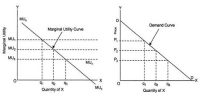The marginal productivity theory was first stated by Von-Thunen. The theory has beers developed by Wick steed Walrus J.B. Clark and many others.
Statement of the theory:
Marginal productivity theory of wage explains that under perfect competition a worker’s wage is equal to marginal as well as average revenue productivity. In other words marginal revenue productivity and average- revenue productivity (ARP) of a worker determine his wages. According to this theory wage of a laborer, is determined by his marginal productivity. In other words MRP= M.W. Marginal productivity is the addition made total productivity by employing one more unit of labor. As the laborers are given money wage their marginal productivity is calculated in terms of money.
This is called marginal revenue productivity (MRP). MRP is the addition made to the total revenue by employing one more unit of a worker. A producer will maximize his profit when the wage of a laborer is equal to the marginal revenue product. If MW is greater than MRP (MW > MRP) wage is greater than marginal revenue product. The producer will sustain loss then. If MW for labor is higher than its marginal revenue product then the employers get less and pay more. Thus he loses.
On the other hand, if the producer pays a wage less than MRP. (ME < MRP) he will gain. But his gain will not be maximized. Thus he will gain by employing workers so long when MW = MRP. Thus the wage of a laborer will be determined where MRP – M.W.
Supposing producer employee 3 laborers with other factors of production. He gets Rs.200 as total revenue i.e. income from the sale of output. If he employed an additional laborer his total revenue increases by Rs. 300. Thus by employing one additional laborer, he adds Rs. (200-100) = Rs.100 to the total revenue, this increase in 100 is called MRP. Under perfect competition. n worker gets wages equal to his marginal revenue productivity.
If the laborers demand more than Rs. 100, the producer will employ a lower number of workers since their new price exceeds their marginal productivity. When less number of workers get a higher wage, the unemployed laborers will bring down the wage to the equilibrium level. I Ultimately wages will tend to equal marginal productivity of workers. in such a situation the producer thinks of employing more laborers to maximize his profit. This process will continue until wages become equal to the worker’s marginal activity.
In the diagram numbers of workers are measured on OX-axis and wages on OY-axis. ARP and MRP are Average revenue product and marginal revenue product and since it is perfect competition OW wage is equal to OW = AW = MW. At point Q, ARP and MRP are equal. This is the point of equilibrium.
At OW wage the no laborers employed is ON. At the employment more than ON level, the firm will add more to his cast and less to his revenue which means loss. Thus the equilibrium level is to employ workers up to the point where MRP (ARP) is equal to the wage rate.
Assumptions:
- Perfect competition prevails in both product and factor market.
- Law of diminishing marginal returns operates on the marginal productivity of
- Labor is homogeneous.
- Full employment prevails.
- The theory is based on the long run.
- Modes of production are constant.
Criticism:
- The theory is based on the assumption of perfect But perfect competition is unreal and imaginary. This theory seems in practicable.
- The theory puts too much on demand It ignores supply side.
- Production is started with the combination of four factors of production. It is ridiculous to say that production has increased by the additional employment of one Employment of an additional laborer amounts nothing in a big scale industry.
- The theory is static. It applies only when no change occurs in the economy. Under depression wage cut will not increase employment.
- This theory explains that wages will be equal to MRP and ARP.
- It is difficult to measure MRP because any product is a joint product of both fixed and variable factors.
- According to Watson, the theory is cruel and harsh. This theory never takes into consideration the marginal product of old, aged, blind etc.











